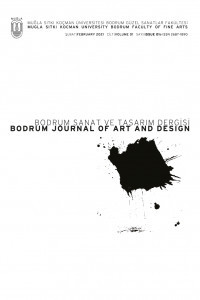Sanat Bağlamında Gündelik Hayatın Eleştirisi ve Sokak Sanatı
Sosyolojide olduğu gibi sanat alanında da “gündelik hayat ve eleştirisi” her zaman önemli konulardan biri olmuştur. Öyle ki; sanat tarihi boyunca gündelik hayatın farklı şekillerde sanata konu edildiğini gözlemlemek mümkündür. Bu çalışma, başlangıcında; gündelik hayatın sanat tarihinin farklı dönemlerine ne şekilde yansıtıldığına genel bir bakış sunar. Çalışmanın amacı; modernizm ile daha görünür hale gelen, “gündelik hayatın eleştirisi” kavramının sanatta ele alınışı üzerinde durmaktır. Ayrıca, araştırma boyunca, modernizm sürecinde sanatın hem üretildiği hem de tüketildiği mekânlardan biri olarak ortaya çıkan “kent, gündelik hayat ve eleştirisinin” yaşandığı en önemli mekân olarak üzerinde durulmaya değer görülmüştür. Dada Hareketi, 70’lerin özgürlük ortamı, 80’ler sonrası neoliberal değişimler gibi süreçler incelendiğinde, kente dair ve kentin içinden bir hareket olarak ortaya çıkan “sokak sanatı”, artık gündelik hayatının çoğunu kentte geçiren sanatçı ve izleyici için, eleştirinin en çok yapıldığı ve gözlendiği yer olmuştur. “Sokak sanatı”, 20. yüzyılın en ünlü düşünürlerinden Michel de Certeau’nun “gündelik hayat pratikleri” ve kent sakinlerinin otoriteye karşı geliştirdiği “taktikler” olarak öne sürdüğü mücadele biçimlerinden biri olarak ele alınabilir. Bu temel perspektiften çalışmada nitel araştırma yöntem olarak kullanılmış, elde edilen veriler doğrultusunda çeşitli sokak sanatçılarının sürdürdüğü mücadeleler incelenmiştir. Sonuçta, sanat ve sermayenin sürekli birbirlerine “karşı taktikler” geliştirerek hem çatıştıkları hem de bu çatışmadan yeni yaratıcı süreçlerin gelişmesine olanak sağladığı görülmektedir.
Anahtar Kelimeler:
Gündelik Hayat, Gündelik Hayatın Eleştirisi, Sokak Sanatı, Kent
The Critic of Everyday Life in the Context of Art and Street Art
As in sociology, “critic of everyday life” has always been one of the important issues in the feld of art. So, it is possible to observe that daily life has been the subject of art in diferent ways throughout the history of art. At frst, this study provides an overview of how everyday life is refected in diferent periods of art history. The aim of the study is to focus on the concept of “criticism of everyday life”, which has become more visible with modernism in art. In addition, throughout the research, the “city”, which emerged as one of the places where art is both produced and consumed in the process of modernism has been deemed worthy to be emphasized as the most important place where daily life and criticism are experienced. When processes such as the Dada Movement, the freedom environment of the 70s, and the neoliberal changes after the 80s are examined, “street art”, which emerged as a movement about and from the city, is now the most criticized place for the artist and the audience who spend most of their daily life in the city has been observed. “Street art” has been considered as one of the forms of struggle put forward by Michel de Certeau, one of the most famous thinkers of the 20th century, as “everyday life practices” and “tactics” developed by city residents against authority. From this basic perspective, qualitative research was used as a method in the study, and in line with the data obtained, the struggles of various street artists were examined. Results show that art and capital both clash with each other by constantly developing "anti-tactics" and allow new creative processes to develop out of this confict.
Keywords:
Everyday Life, Criticism of Everyday Life, Street Art, City,
___
- Artan, E. Ç. (2012). Sokaklar ve yeni sanat pazarı: Keith Haring’in evreni. Sanat Blog. http://www.sanatblog.com/sokaklar-yeni-sanat-pazari-keith/ (23.02.2022).
- Artun, A. (Ed.). (2015). Sanat manifestoları avangard sanat ve direniş (K. Özsezgin vd., Çev.). İletişim Yayınları.
- Cleave, M. (1966, 4 Mart). How does a beatle live? John Lennon lives like this. London Evening Standard. http://www.beatlesinterviews.org/db1966.0304-beatles-john-lennon-were-more-popular-than-jesus-now-maureen-cleave.html (05.04.2022).
- Deniz, A. Ç., Kentel, F. (2016). De Certeau: Operasyonlar, strateji, taktik ve kent. Tarih Okulu Dergisi, 9(25), 747-761. http://dx.doi.org/10.14225/Joh888
- Gombrich, E. H. (2009). Sanatın öyküsü (Ö. Erduran ve E. Erduran, Çev.). Remzi Kitabevi.
- Gök, M., Aydın, S. (2020). Gündelik hayat bağlamında dönüşen sanat. Sosyal Bilimler Enstitüsü Dergisi, 8(15), 229-246.
- Gökova, H. (2020). Sokak sanatında üsluba dair yorumlar ve muhalif boyut. Yedi: Sanat, Tasarım ve Bilim Dergisi, 23, 97-107. https://doi.org/10.17484/yedi.620033
- Havası, E. B. (2019). Kentsel mekânda ayrışmanın gündelik hayata ve kişisel sanat pratiğine etkisi [Sanatta Yeterlik Sanat Çalışması Raporu, Hacettepe Üniversitesi].
- Karaaslan, E. (2008). Alt-kültürler ve sokak sanatı [Yüksek Lisans Tezi, Dokuz Eylül Üniversitesi].
- Kırış, E. (2019). Fransız Sosyoloji’sinde gündelik hayat çalışmaları. Sosyal ve Kültürel Araştırmalar Dergisi, 5(9), 131- 145. https://doi.org/10.25306/skad.538256
- Lefebvre, H. (2013). Gündelik hayatın eleştirisi I (I. Ergüden, Çev.). Sel Yayıncılık.
- Seçen, İ. (t. y.). Jean-Michel Basquiat: Çağdaş sanatın aykırı dahisi. İyi ki görmüşüm. https://iyikigormusum.com/sanatin-aykiri-dahisi-basquiat (24.02.2022).
- The Guardian. (2014). Why we painted over Berlin’s most famous graffiti/ Lutz Henke, co-creator of the Kreuzberg Murals. The Guardian News. https://www.theguardian.com/commentisfree/2014/dec/19/why-we-painted-over-berlin-graffiti-kreuzberg-murals (24.02.2022).
- Türkiye Cumhuriyeti Çevre, Şehircilik ve İklim Değişikliği Bakanlığı. (2018). Dünya Bankası Göstergeleri. https://cevreselgostergeler.csb.gov.tr/kentsel---kirsal-nufus-orani-i-85670 (05.04.2022).
- Yayın Aralığı: Yılda 2 Sayı
- Başlangıç: 2022
- Yayıncı: Mugla Sitki Kocman University
Sayıdaki Diğer Makaleler
Hastane Tasarımlarının Geçmişten Günümüze Değişiminin Hasta Odaları Üzerinden İncelenmesi
Dijital Çağda Sanat Eserinin Biricikliği Üzerine
Batu BOZOĞLU, Eda ÇEKİL KONRAT
Sanat Bağlamında Gündelik Hayatın Eleştirisi ve Sokak Sanatı
Esma Burcu HAVASI, Kaan CANDURAN
Changing Paradigm of Urban Legibility: The Case of Atakule Shopping Mall
Kurumsal Kimlik Kılavuzu Nedir? Koç Holding Kurumsal Kimlik Kılavuzunun İncelenmesi
Benzersiz ve Alışılmadık: Martin Kardeşler ve Seramikleri
“Garbage In, Garbage Out” Disposal of Waste: A Concept for Reviving Plastic Waste into Art Objects
John Frank ESHUN, Evans Kwadwo DONKOR
